Purchas D. Handbook of Filter Media
Подождите немного. Документ загружается.

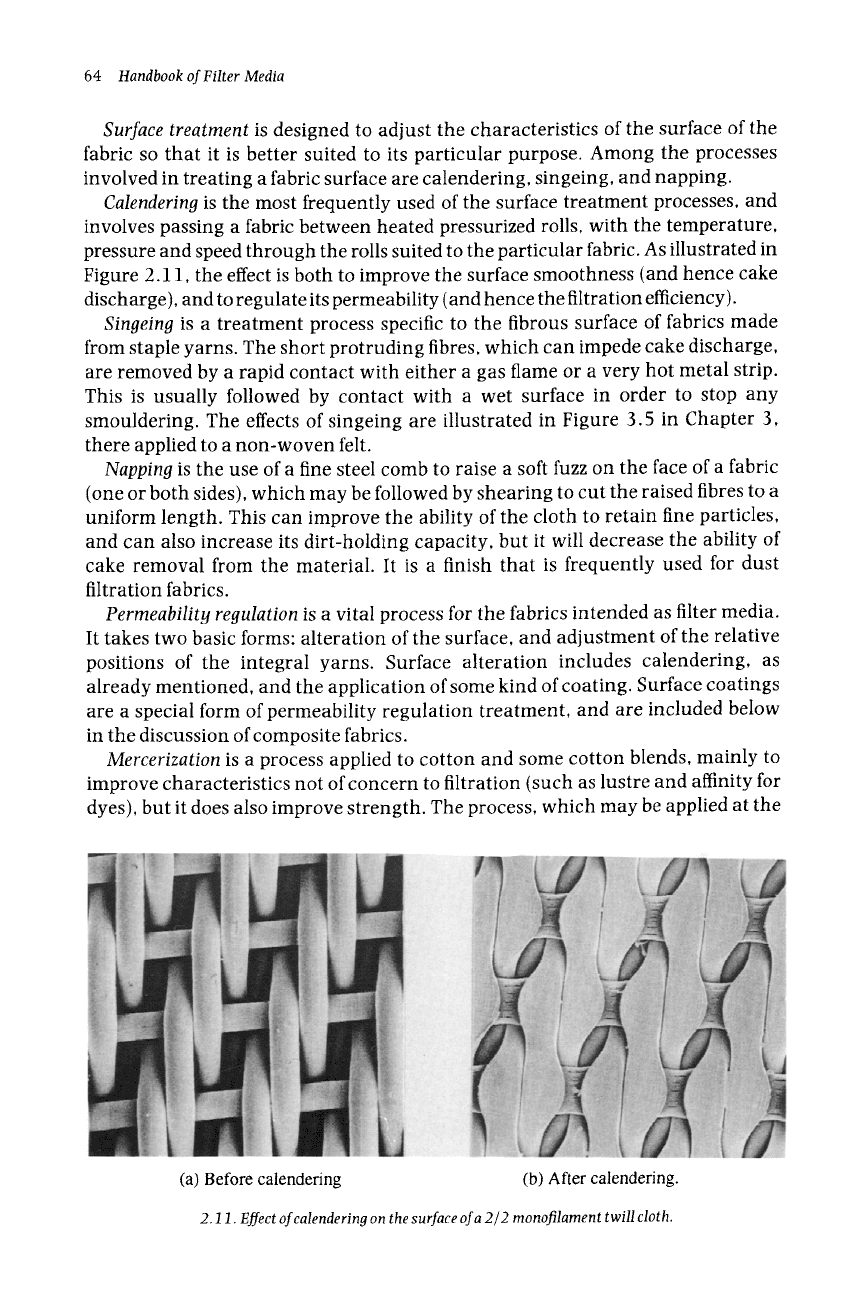
64
Handbook of Filter Media
Surface treatment
is designed to adjust the characteristics of the surface of the
fabric so that it is better suited to its particular purpose. Among the processes
involved in treating a fabric surface are calendering, singeing, and napping.
Calendering
is the most frequently used of the surface treatment processes, and
involves passing a fabric between heated pressurized rolls, with the temperature,
pressure and speed through the rolls suited to the particular fabric. As illustrated in
Figure 2.11, the effect is both to improve the surface smoothness (and hence cake
discharge), and to regulate its permeability (and hence the filtration efficiency).
Singeing
is a treatment process specific to the fibrous surface of fabrics made
from staple yarns. The short protruding fibres, which can impede cake discharge,
are removed by a rapid contact with either a gas flame or a very hot metal strip.
This is usually followed by contact with a wet surface in order to stop any
smouldering. The effects of singeing are illustrated in Figure 3.5 in Chapter 3,
there applied to a non-woven felt.
Napping
is the use of a fine steel comb to raise a soft fuzz on the face of a fabric
(one or both sides), which may be followed by shearing to cut the raised fibres to a
uniform length. This can improve the ability of the cloth to retain fine particles,
and can also increase its dirt-holding capacity, but it will decrease the ability of
cake removal from the material. It is a finish that is frequently used for dust
filtration fabrics.
Permeability regulation
is a vital process for the fabrics intended as filter media.
It takes two basic forms: alteration of the surface, and adjustment of the relative
positions of the integral yarns. Surface alteration includes calendering, as
already mentioned, and the application of some kind of coating. Surface coatings
are a special form of permeability regulation treatment, and are included below
in the discussion of composite fabrics.
Mercerization
is a process applied to cotton and some cotton blends, mainly to
improve characteristics not of concern to filtration (such as lustre and affinity for
dyes), but it does also improve strength. The process, which may be applied at the
(a) Before calendering
(b) After calendering.
2.11. Effect of calendering on the surface of a 2/2 monofilament twill cloth.

Woven Fabric Media 6 5
yarn or fabric stage, involves immersion under tension in a caustic soda solution,
followed by neutralization with acid. The treatment produces permanent
swelling of the fibre, and hence changes the permeability of the fabric.
Tentering
is a final process used to set the warp and weft of woven fabrics at
right angles to each other, and to stretch and set the fabric to its final dimensions.
Tentering stretches the fabric under tension by the use of a tenter flame, which
travels on tracks through a heated chamber, to remove creases and wrinkles, to
straighten the weave, and to dry the fabric to its final size. When the process is
applied to synthetic fibres it is sometimes called
heat-setting,
a term also applied to
the permanent setting of pleats, creases, and special surface effects.
2.3.7.3
Composite fabrics
When a second layer of fabric is joined to a first to make a
composite fabric,
then
an element of confusion enters into the definition, as to whether the second
material enhances the filtration performance of the first, or whether it completely
changes the filtration regime of the resultant medium, with the second layer
taking over the filtration function. The latter situation is exemplified by the laying
down of a membrane layer over a woven substrate, such that the membrane does
all of the filtration, and the woven material is only a support for the membrane.
Composite fabrics of the second kind, which are effectively membrane media with
woven fabric supports, are discussed in Chapter 8. The present section
concentrates on coated woven fabrics, and multi-layer woven materials.
Surface coatings
have become an important part of the woven fabric media
business. The coating, which may be sprayed on as a liquid, or laid down as a
thin sheet that is then bonded to the fabric, or even pushed into it, is primarily
there to modify the surface permeability, but may also have other beneficial
properties. (See also Section 3.3.1.2 for more information on coatings.)
Microporous polymer coatings can be applied to the face of woven and non-
woven fabrics, both to achieve finer filtration, and to improve cake discharge.
Examples of this format are provided by the various Ravlex coatings, supplied by
Ravensworth; MP and HP grades are made from tetrafluoroethylene
terpolymers, applied in liquid form, to provide a very robust coating with 5-8 ~m
pores. The scanning electron micrograph in Figure 3.6 in Chapter 3 shows a
Ravlex coating on a non-woven fabric.
A polyurethane coating on a substrate of woven polyester is the basis of
Madison's Primapor fabrics, introduced for use on process filters such as rotary
drums and filter presses, shown in Figure 2.12. A development of this, the
Azurtex coatings, again of polyurethane, on a polypropylene or polyester
substrate, are impressed into the fabric. This gives a more durable finish,
although the pore size is higher (6 ~m, compared to 2.5-4 pm for Primapor).
Madison also has a Tuf-Tex finish, of specially formulated resin, for woven (and
non-woven) fabrics, although this is intended as an abrasion-resistant coating
rather than permeability changing.
Laminated fabrics
involve two or more layers of woven material, fixed together,
either firmly or loosely. It is common practice in filtration to assemble several
layers of different fabric on top of each other, with the finest on top as the main
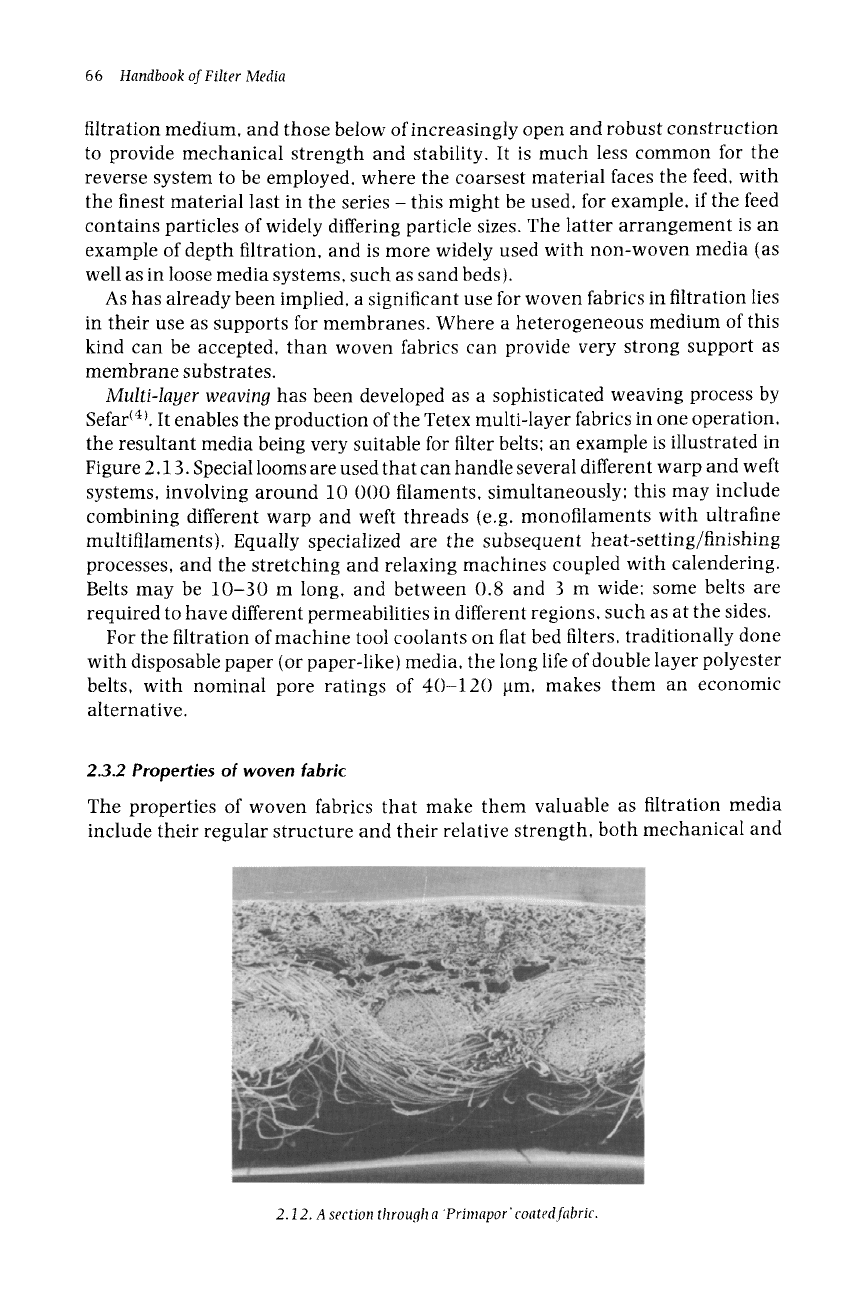
66
Handbook of Filter Media
filtration medium, and those below of increasingly open and robust construction
to provide mechanical strength and stability. It is much less common for the
reverse system to be employed, where the coarsest material faces the feed, with
the finest material last in the series - this might be used, for example, if the feed
contains particles of widely differing particle sizes. The latter arrangement is an
example of depth filtration, and is more widely used with non-woven media (as
well as in loose media systems, such as sand beds).
As has already been implied, a significant use for woven fabrics in filtration lies
in their use as supports for membranes. Where a heterogeneous medium of this
kind can be accepted, than woven fabrics can provide very strong support as
membrane substrates.
Multi-layer weaving
has been developed as a sophisticated weaving process by
Sefar t4~. It enables the production of the Tetex multi-layer fabrics in one operation,
the resultant media being very suitable for filter belts: an example is illustrated in
Figure 2.13. Special looms are used that can handle several different warp and weft
systems, involving around 10 000 filaments, simultaneously: this may include
combining different warp and weft threads (e.g. monofilaments with ultrafine
multifilaments). Equally specialized are the subsequent heat-setting/finishing
processes, and the stretching and relaxing machines coupled with calendering.
Belts may be 10-30 m long, and between 0.8 and 3 m wide: some belts are
required to have different permeabilities in different regions, such as at the sides.
For the filtration of machine tool coolants on flat bed filters, traditionally done
with disposable paper (or paper-like) media, the long life of double layer polyester
belts, with nominal pore ratings of 40-120 ~m. makes them an economic
alternative.
2.3.2 Properties of woven fabric
The properties of woven fabrics that make them valuable as filtration media
include their regular structure and their relative strength, both mechanical and
2.12. A section through a 'Primapor'coated fabric.
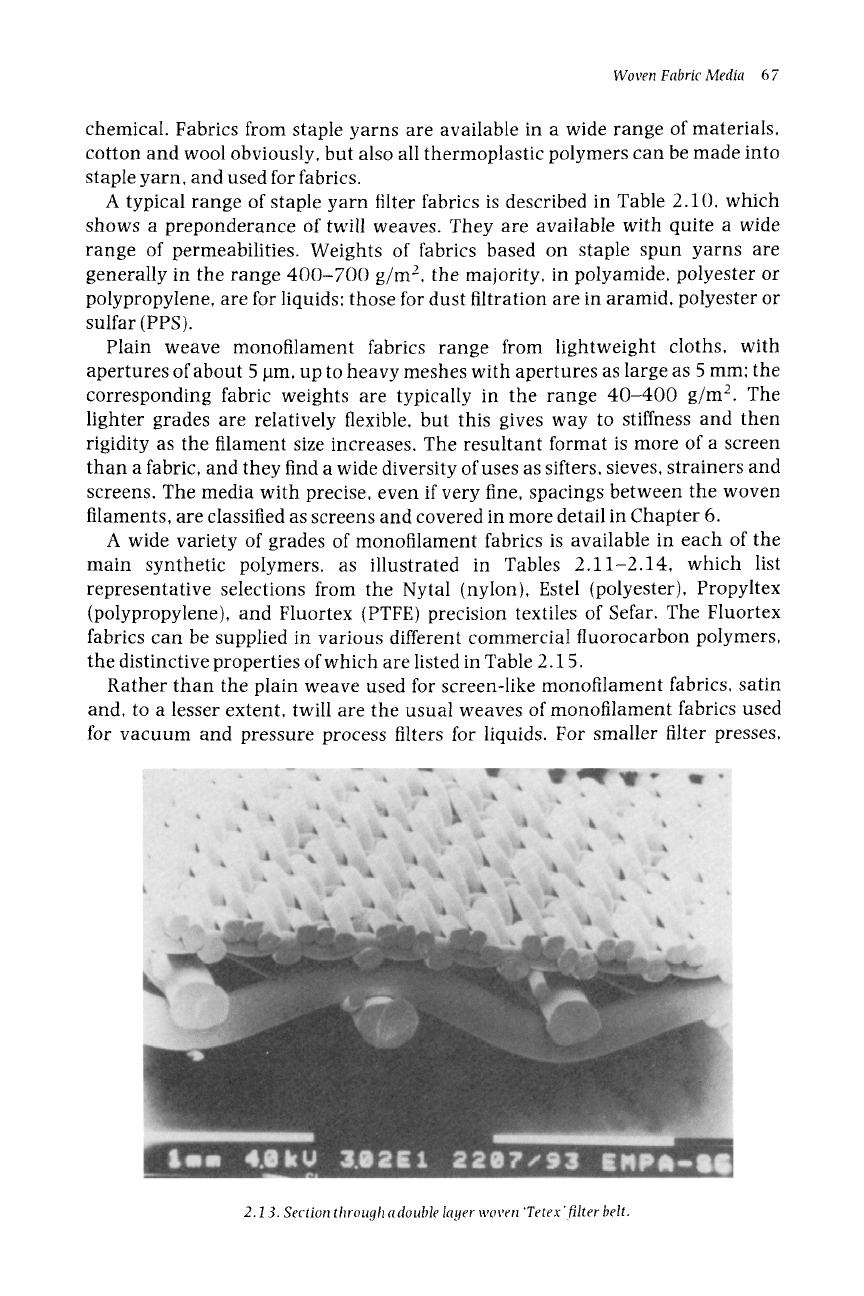
Woven Fabric Media 6 7
chemical. Fabrics from staple yarns are available in a wide range of materials,
cotton and wool obviously, but also all thermoplastic polymers can be made into
staple yarn, and used for fabrics.
A typical range of staple yarn filter fabrics is described in Table 2.10, which
shows a preponderance of twill weaves. They are available with quite a wide
range of permeabilities. Weights of fabrics based on staple spun yarns are
generally in the range 400-700 g/m 2, the majority, in polyamide, polyester or
polypropylene, are for liquids: those for dust filtration are in aramid, polyester or
sulfar (PPS).
Plain weave monofilament fabrics range from lightweight cloths, with
apertures of about 5 ~m, up to heavy meshes with apertures as large as 5 mm: the
corresponding fabric weights are typically in the range 40-400 g/m 2. The
lighter grades are relatively flexible, but this gives way to stiffness and then
rigidity as the filament size increases. The resultant format is more of a screen
than a fabric, and they find a wide diversity of uses as sifters, sieves, strainers and
screens. The media with precise, even if very fine, spacings between the woven
filaments, are classified as screens and covered in more detail in Chapter 6.
A wide variety of grades of monofilament fabrics is available in each of the
main synthetic polymers, as illustrated in Tables 2.11-2.14, which list
representative selections from the Nytal (nylon), Estel (polyester), Propyltex
(polypropylene), and Fluortex (PTFE) precision textiles of Sefar. The Fluortex
fabrics can be supplied in various different commercial fluorocarbon polymers,
the distinctive properties of which are listed in Table 2.15.
Rather than the plain weave used for screen-like monofilament fabrics, satin
and, to a lesser extent, twill are the usual weaves of monofilament fabrics used
for vacuum and pressure process filters for liquids. For smaller filter presses,
2.13. Section through a double layer woven 'Tetex" filter belt.
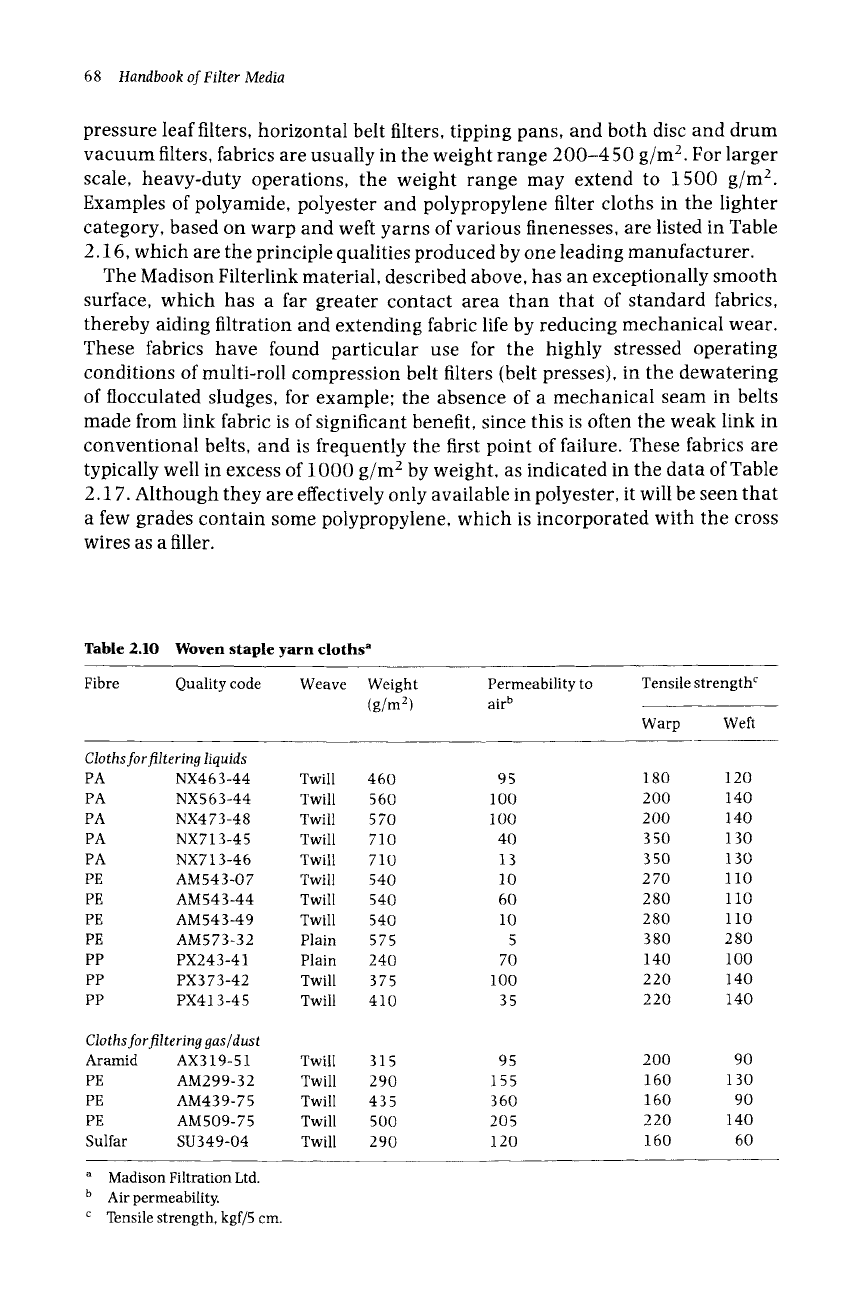
68
Handbook of Filter Media
pressure leaf filters, horizontal belt filters, tipping pans, and both disc and drum
vacuum filters, fabrics are usually in the weight range 200-450 g/m 2. For larger
scale, heavy-duty operations, the weight range may extend to 1500 g/m 2.
Examples of polyamide, polyester and polypropylene filter cloths in the lighter
category, based on warp and weft yarns of various finenesses, are listed in Table
2.16, which are the principle qualities produced by one leading manufacturer.
The Madison Filterlink material, described above, has an exceptionally smooth
surface, which has a far greater contact area than that of standard fabrics,
thereby aiding filtration and extending fabric life by reducing mechanical wear.
These fabrics have found particular use for the highly stressed operating
conditions of multi-roll compression belt filters (belt presses), in the dewatering
of flocculated sludges, for example: the absence of a mechanical seam in belts
made from link fabric is of significant benefit, since this is often the weak link in
conventional belts, and is frequently the first point of failure. These fabrics are
typically well in excess of 1000
g/m 2
by weight, as indicated in the data of Table
2.17. Although they are effectively only available in polyester, it will be seen that
a few grades contain some polypropylene, which is incorporated with the cross
wires as a filler.
Table 2.10 Woven staple yarn cloths a
Fibre Quality code Weave Weight Permeability to Tensile strength c
(g/m 2) air b
Warp Weft
Cloths for filtering liquids
PA NX463-44 Twill 460 95 180 120
PA NX 563-44 Twill 560 100 200 140
PA NX473-48 Twill 570 100 200 140
PA NX713-45 Twill 710 40 350 130
PA NX713-46 Twill 710 13 350 130
PE AM543-07 Twill 540 10 270 110
PE AM543-44 Twill 540 60 280 110
PE AM543-49 Twill 540 10 280 110
PE AM573-32 Plain 575 5 380 280
PP PX243-41 Plain 240 70 140 100
PP PX373-42 Twill 375 100 220 140
PP PX413-45 Twill 410 35 220 140
Cloths for filtering gas~dust
Aramid AX319-51 Twill 315 95 200 90
PE AM299-32 Twill 290 155 160 130
PE AM439- 75 Twill 435 360 160 90
PE AM509-75 Twill 500 205 220 140
Sulfar SU 349-04 Twill 290 120 160 60
a Madison Filtration Ltd.
b Air permeability.
c Tensile strength, kgf/5 cm.

Table 2.11 Examples of 'Nytal' nylon precision monofilament textiles a
Reference no.
N4000 N2000 N1000 N800 N600 N500 N390 N300 N224 N100 N80 N56 N35 N20 N15HD N10HD N5HD
Aperture (~tm) 4000 2000 1000 800 600 500 390 300 224
Warpmeshes/cm 2.0 3.64
7.57
9.26 11.9 13.9 17.6 22.7 29.1
Weffmesh/cm 2.0 3.64
7.57
9.26 11.9 14.3 17.6 22.7 29.1
Thread dia. (~tm)
Warp 1 ()()() 750 320 280 240 220 180 140 120
Weft 1()()() 750 320 280 240 2()() 180 140 120
Thickness of 244() 1 580 630 505 445 39() 325 250 220
fabric (lain)
Open area (%) 64 53 58 55 51 5() 47 47 43
Weight(g/m 2) 395 395 160 140 133 119 105 76 80
Permeability to aiP' - - 60()() 5800 5760 534() 537() 5100 4710
Permeability to .........
water c
Bursting pressure a - - 1 7.5 20.5 19.5 19.5 1 7.5 1 5.() I 5.5
100 80 56 35 20 15 10 5
57.8 67.8 101 100.5 185 185 190 200
66.7 81.3 1()1 128.2 185 185 190 200
60+ 50+ 43 43 34 39 42 2•
2x5() 2x43
50 43 43 2x43 34 39 42 2x43
105 92 71 97 45 43 4() 80
38 ]5 32 16 14
8 4 1
35 35 ]7 49 32 32 32 6()
339() 22()(1 213() 15()() 51() 320 18() 30
492 46() 420 334 130 60 48 5.4
6.() 6.5 8.5 1 ().(I 7.5 7.5 7.5 1 5.5
Sefar.
b Air permeability,
l/dm2/min (w20
mmWG.
c Water permeability, 1/dm2/min (as 500 mmWG.
d Bursting pressure, kg/cm 2.

70
Handbook of Filter Media
%
u
o~
@
@
m
@
ou
oN
@
@
N
~ L~ ,,~ X ~ Lt" U~ ~ ~, ~
~ m ,,.C X ~ m u",
t"q ~'~ ,..,. t'q ~ 3o b... ::)O
u'~ ~ ~.~ X ~ ,,~ b.. ~',
r.,!
Lf~ Lt~
eN ~ t~
,-- t~.
11",
e".l t~
:~
.
t~ I (".
t~ t~.
,-- t~.
t~, I
'--
3
~., ,~, ,~, ~ Lt ~ "~.
e"4 e'4 ,.--, :~ u~ tl'~ 0"~
t"4 ~'~ ~'~ 3~, ~ ,...- ts t~ I
B
E
,.-.,
B
B
5
o,-,
.....,
B
i...,
B
B
B ~
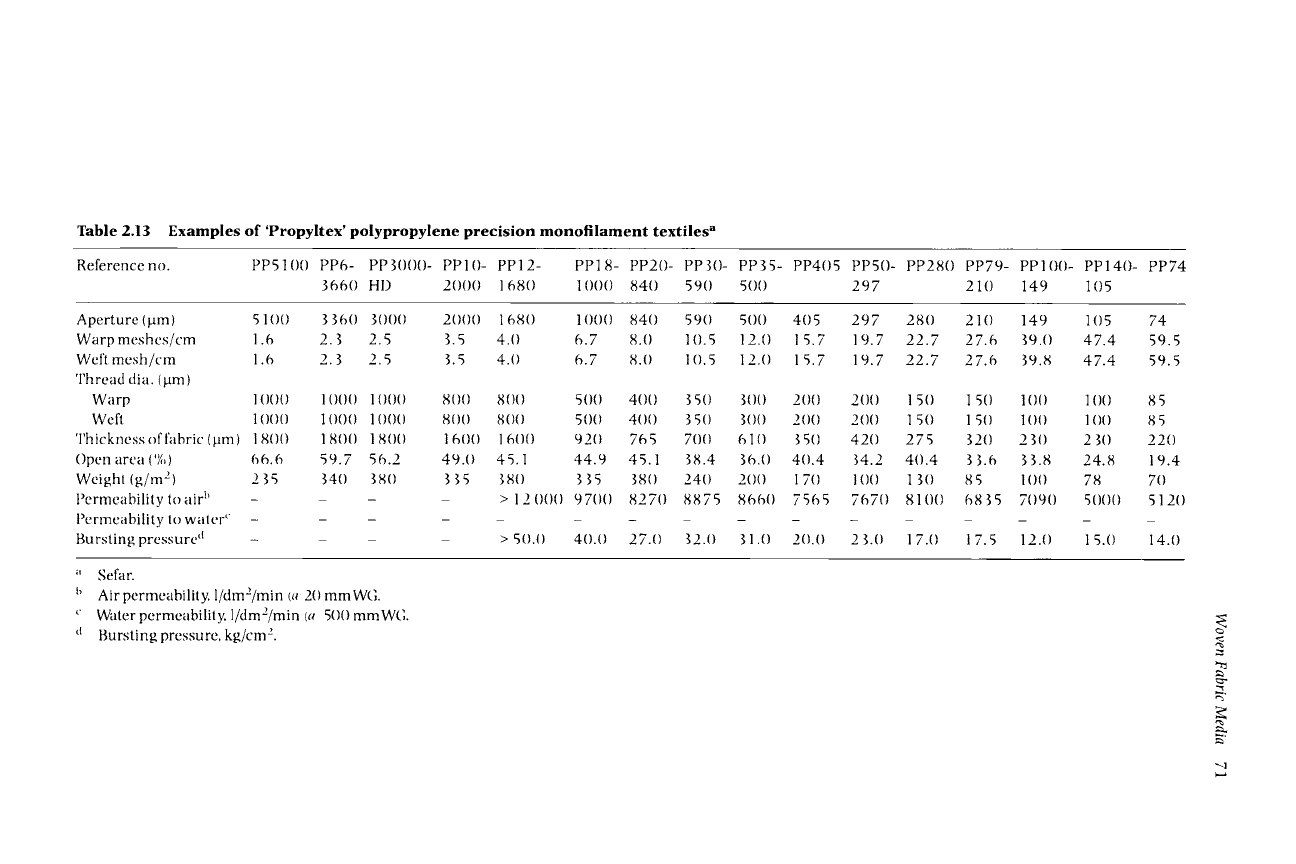
Table 2.11 Examples of 'Propyltex' polypropylene precision monofilament textiles a
Reference no.
PPSl()() PP6- PP3()()()- PPl()- PP12-
3660
HI_) 2()()() 1680
PPl8- PP2()- PP3()- PP35- PP4()5 PP5()- PP280 PP79- PPI()()- PP140- PP74
1 ()()() 84() 590 5()() 297 210 149 105
Aperture (l.tm) 51()() 336() 3()()() 2()()()
Warp meshes/cm 1.6 2.3 2.5 3.5
Weft mesh/cm 1.6 2.3 2.5 3.5
Thread dia. (l~m I
Warp 1 ()()() 1 ()()() 1 ()()() 8()()
Weft, l ()()() 1 (}()() 1 ()()() 8()()
Thickness of fabric (lam) 18()() 18()() 18()() 16()()
()pen area(%) 66.6 59.7 56.2 49.()
Weight (g/m e) 2 35 34() 38() 335
l'ermeabilily 1o air b - - - -
Permeability to waler' ....
Bursting pressure d ....
168() 100() 840 59() 50() 405 297 280 210 149 105 74
4.() 6.7 8.() 1().5 12.() 1 5.7 19.7 22.7 27.6 39.() 47.4 59.5
4.() 6.7 8.() 1().5 12.() 1 5.7 19.7 22.7 27.6 39.8 47.4 59.5
8()() 5()()
8()() 5()()
16()() 92()
45.1 44.9
38() 335
>12()()() 97()()
> 5().() 4().()
4()() 35() 3()() 2(}(} 2()() 15() 1 5() 1 ()(} 1 ()() 85
4()() 35() 3()() 2()() 2()() 1 5() 1 5() 1 ()() 1 ()() 8 5
765 7()() 61() 35() 42() 275 32() 23() 2 3() 220
45.1 38.4 36.() 4().4 34.2 40.4 33.6 33.8 24.8 19.4
38() 24() 2()() 1 7() 1 ()() 1 3() 8 5 1 ()() 78 7()
827() 8875 866() 7565 767() 81()() 6835 7()9() 5()()() 512()
27.() 32.() 31.() 2().() 23.() 17.() 17.5 12.() 15.() 14.()
" Sefar.
b Air permeability, l/dm2/min (a!2() mmWG.
" Water permeability,
l/dm2/min (a,
50() mmWG.
d Burstingprcssurc, kg/cm 2.

72
Handbook of Filter Media
m
o
o
~
~
o
o
o
o
r,.)
~5
g~
oo ~ o
oo q o
044 oss -c
9 .
L,
9
._.e.
.,,.,,,
L
,.s
'-I.
t',4
#
r~
0
.<
II
%)
o
#
II
P_,.,
D,.,
o
II
.......
E
"~=
Z ,~

Table 2.15 Properties of alternative PFTE polymers used in SST 'Fluortex' textiles
Fibre (monofllament) FEP PFK LX (ETFE)
(Teflon) (Hostaflon) (Tefzel) (Luxel)
LX (E-CTFE)
(Luxilar) (Halar)
COP (Aflon)
PVDF
Properties
Specific gravity
Tensile strength (kg/mm 2) (dry)
Rel. tenacity (wet %)
Elongation at break (%) (dry)
Elongation at break (%) (wet)
Moisture absorption (%) at
65% rel. hum and 2()~ (68~
Melting point (~
Softening point (~
Temperature resistance
or approx, limiting temp.
in dry condition
(permanent temperature )
Resistance to light
Abrasion resistance
Resistance and reactions
to acids
Resistance to alkalis and
reaction with caustics
Reaction to organic solvents (as
used for instance for dry cleaning)
Special feature
2.12 1.75-1.77 1.70 1.69 1.73-1.76 1.78
11-2 3 35-60 45-60 45-60
40-4 7 40-45
100 100 100 100 100 100
20-70 20-45 2 5-45 2 5-45 2,5-35 30-60
20-70 20-45 2 5-45 2 5-45 2 5-35 30-60
0 0 () 0 () 0.04
285 270 270 245 265-270 170-180
275 265 260 235 260 155
- 19()~ -2()()~ to -2()()~ to -6()~ to
-
1
8()~ to
-5()~
to
to +2 32~ +15()~ +1 55~ +15()~ +1 5()~ +I()()~
short-termed evt. to + 18()~
to 26()~
permanent
temperature
to 2()5~
Excellent Excellent Excellent Excellent Excellent Very good
Average Average Average Average Average Average
to good to good to good to good to good to good
Very Very Very Very Very Very good
resistant resistant resistant resistant resistant
Very Very Very Very Very Very good
resistant resistant resistant resistant resistant
Insoluble Insoluble Insoluble Insoluble Insoluble Partly
resistant
Anti- Anti- Anti- Anti- Anti- Anti-
adhesive adhesive adhesive adhesive adhesive adhesive
